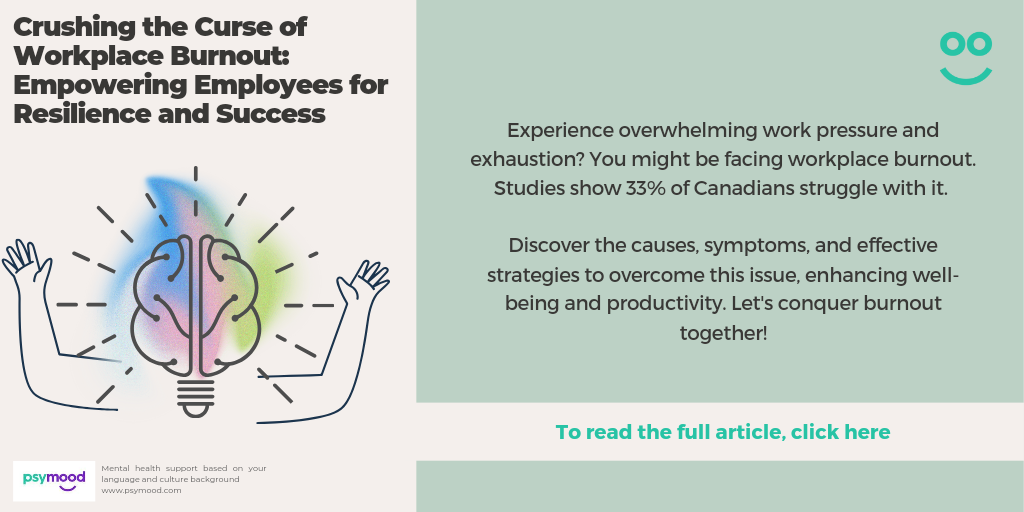Crushing the Curse of Workplace Burnout: Empowering Employees for Resilience and Success
Ever felt overwhelmed by work pressure, stagnating under the weight of expectations and an excessive workload? If so, you may have experienced workplace burnout- a state of chronic physical and emotional exhaustion caused by prolonged stress. According to recent studies, approximately 33% of Canadians report experiencing workplace burnout. In this article, we explore the causes, symptoms, and strategies to overcome this prevalent issue, promoting well-being and productivity in the workplace.
Decoding Workplace Burnout: Symptoms, Causes, Impact
Workplace burnout is characterized as an enduring condition of both physical and emotional exhaustion that emerges due to the prolonged and overwhelming stress experienced within the work environment. It affects individuals of all professional backgrounds and can have a significant impact on their overall well-being. While some may experience burnout due to work-related demands, others may develop it as a result of organizational factors or personal circumstances. Burnout can manifest through various symptoms such as fatigue, cynicism, reduced productivity, and feelings of detachment. It is crucial to recognize and address burnout to foster a healthier and more sustainable work culture.
Workplace burnout can manifest differently in individuals, and recognizing the symptoms is crucial for early intervention
While specific indicators may vary, there are common signs to watch out for:
- Persistent feelings of exhaustion and fatigue
- Decreased productivity and engagement
- Emotional detachment and cynicism toward work
- Increased errors and difficulty concentrating
- Physical symptoms such as headaches or muscle tension
To address workplace burnout, it is vital to foster a supportive environment. Tailoring accommodations to employees’ needs is essential. Here are some effective strategies:
- Enhance clarity in communication by providing clear instructions and expectations.
- Break down tasks into manageable steps to alleviate overwhelm and enhance information processing.
- Establish structured work environments with routines, schedules, and realistic deadlines. Read some tips on Reducing Stress at your Desk: Zen Office Workspace
- Help employees prioritize tasks and set achievable goals, utilizing visual aids and digital tools.
- Leverage individual strengths by assigning projects aligned with their capabilities.
- Offer regular, constructive feedback and recognition to motivate and boost self-esteem.
By cultivating a burnout-aware workplace culture, organizations can unlock higher productivity, nurture creativity, and create an inclusive environment where everyone can thrive.
Understanding Burnout: Consequences and Coping Strategies
When burnout takes hold, its consequences can be profound, affecting both individuals and organizations. Burnout can reduce creativity, lower productivity, and negatively impact overall well-being. However, there are effective strategies to regain motivation and overcome burnout’s effects.
- Recognize the Warning Signs and Prioritize Self-Care: When burnout strikes, it can have profound effects on individuals and organizations. Pay attention to signs of exhaustion, apathy, cynicism, and lack of motivation. Take action by practicing self-care, prioritizing rest, engaging in activities that bring you joy, and fostering meaningful connections. Here are some tips on Five ways to combat Burnout
- Rediscover Your Passion: To overcome burnout, reignite your passion for work. Identify the aspects that excite and fulfill you. Align tasks with your strengths and values, allowing passion to propel you forward, even during challenging times. Put your Mental Health as Top Priority
- Seek Support and Connection: Don’t face burnout alone. Seek support from friends, mentors, or colleagues who can provide guidance and motivation. Shared experiences can help you find your way back to a place of inspiration and resilience.
- Foster a Culture of Well-being: Create a work environment that prioritizes well-being. Encourage open communication, promote work-life balance, and provide flexibility. By fostering a supportive culture, you can prevent burnout and promote a healthier, more fulfilling work experience.
Empowering Employees to Overcome Workplace Burnout: Igniting Resilience and Well-being
In today’s fast-paced work environments, workplace burnout has become a prevalent issue, impacting both individuals and organizations. However, there is hope and a path to overcome this challenge. By empowering employees to combat burnout, we can create a resilient and thriving workforce. Here are key strategies to empower employees and foster their well-being:
- Prioritize Work-Life Balance: Encourage flexible work arrangements, allowing employees to maintain a healthy equilibrium between work and personal life.
- Promote Self-Care: Emphasize the importance of self-care practices such as regular breaks, physical activity, and stress management techniques. 5 ways to Love Yourself with Self-Care
- Establish a Supportive Work Environment: Create a culture that values open communication, provides resources for mental health support, and promotes a positive work atmosphere.
- Develop Emotional Intelligence: Enhance employees’ emotional intelligence skills to help them manage stress, build resilience, and cultivate healthy relationships.
- Foster Growth and Development: Offer opportunities for skill-building, career advancement, and personal growth, promoting a sense of purpose and fulfillment.
By implementing these strategies, we can empower employees to overcome workplace burnout, fostering their well-being, engagement, and productivity. Together, we can create a work culture that supports and values the holistic needs of our employees.
Let us know below in the comments section about any challenges you face at your company.
PsyMood offers Enterprise solutions for small, medium and large companies. For more information, email us at partnerships@psymood.com.
PsyMood is a digital tool designed to help you find the support you need in the language that you are most comfortable with. PsyMood considers cultural background, geographical location, interests, and personal needs, amongst other factors, to pair you with service providers for either online or in-person therapy sessions.
Reference:
World Health Organization. (2019). Burn-out an « occupational phenomenon »: International Classification of Diseases. Retrieved from https://www.who.int/news/item/28-05-2019-burn-out-an-occupational-phenomenon-international-classification-of-diseases


.png)
.png)
.png)
Recent Comments